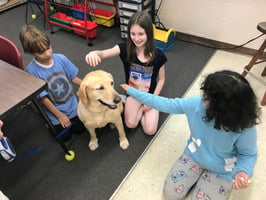School can be stressful at any school year or age. Grade schoolers must learn how to be away from...
Empowering Student Voices: Shaping School Culture and Community
In our recent Digital Leadership Academy Webinar, we explored the dynamic interplay between student voices and school leadership. Let’s dive into the insights shared, including why student voices matter, how to involve them in school decisions, and tips to better capture their perspectives.
The Vital Role of Student Voices
Sometimes, it’s easy to forget that students are primary stakeholders in the education system. Their experiences, needs, and points of view directly influence the effectiveness and relevance of a school district’s policies, programs, and practices.
Moreover, their unique insights into their learning environments can offer valuable feedback for administrators; after all, students know what’s happening in their schools better than just about anyone else.
During the Impact Group’s latest webinar on Student Voice, Wooster High School Principal Scott Musser articulated his compelling rationale for prioritizing student voices: it fosters a sense of belonging among students.
Rather than administrative decisions being top-down directives, Musser has found that hearing what students have to say results in them owning the culture of their school buildings. And by empowering students to voice their opinions and take on this level of ownership, schools can cultivate a deeper sense of belonging for students as well as mutual respect.
Winning Ways to Capture Student Voices
Fortunately, there are many ways for administrators to capture student perspectives effectively. In the webinar, Impact Group Account Lead Rory Wilson highlighted various avenues through which student voices can be harnessed and amplified.
Through strategic planning, feedback forms, surveys, focus groups, and student councils, students are able to contribute to important long-term planning and district initiatives. These forums can serve as conduits through which students can articulate their thoughts and contribute meaningfully to positive change. By implementing a combination of these strategies, administrators can create a culture of transparency and collaboration where student voices are integrated into the decision-making process.
Administrators can also leverage students’ understanding of technology and their creative thinking to share stories with a broader audience. Many school districts already encourage students to participate or even fully manage social media accounts for certain clubs, sports teams, or committees; this type of engagement can make students feel more valued and foster authentic dialogue between them and the wider school community.
Tips for Administrators
If you’re an administrator or school leader looking to give students a platform to express their opinions, there are several tips to streamline the process. Based on our experience working with local schools, here are our tried-and-tested tips for success:
-
Celebrate student participation
Encourage all types of students – from the outspoken to the reserved – to participate in meaningful conversations. Thank each student for their willingness to participate and boldly celebrate the fact that their voices are incredibly valuable to the school. -
Honor the time commitment
In many cases, student participation will involve giving up their free time to offer their feedback. Beyond providing rewards like food or freebies, it’s important they know how much you appreciate their time commitment, so make sure to voice this to them.
-
Be willing to act
Don’t let the act of sharing their thoughts, opinions, and time be a symbolic effort. Rather, put intention behind making positive changes if it’s possible. If a real need is voiced among students, do your best to address it and take it as far as you can. -
Just have fun!
Remember: students are creative and unique, so just have fun with them as you engage them in the feedback process. Keep the conversation upbeat and find ways to make the sessions positive, constructive, and gratifying.
Wrapping Up
In essence, the journey toward amplifying student voices begins with a simple yet profound gesture: listening. Whether through formal feedback mechanisms or informal conversations during lunch breaks, creating spaces where students feel heard, valued, and empowered is paramount to cultivating a vibrant school culture that’s rooted in mutual respect.
By embracing student perspectives, fostering leadership skills, and rolling out opportunities for meaningful engagement, schools can unleash the full potential of their students.
Watch the 30-minute webinar recording to hear The Impact Group's Phil Herman and Aurora Wilson with special guest Wooster High School Principal Scott Musser as they breakdown key components of incorporating student voice.
Looking for other ways to improve your communication efforts, develop leadership skills and positively engage your school community?
Subscribe to The Impact Group monthly newsletter. We swear on our keyboards, it'll be the highlight of your inbox!






